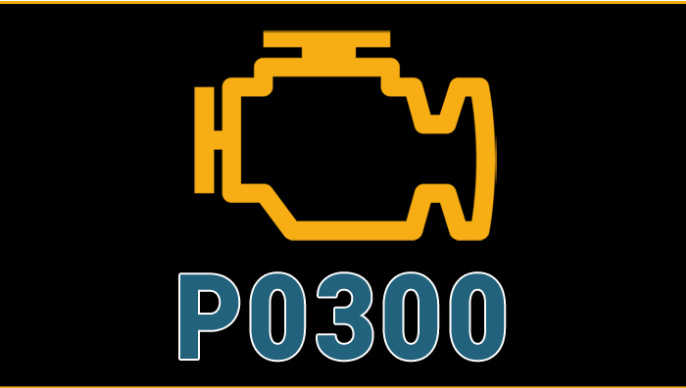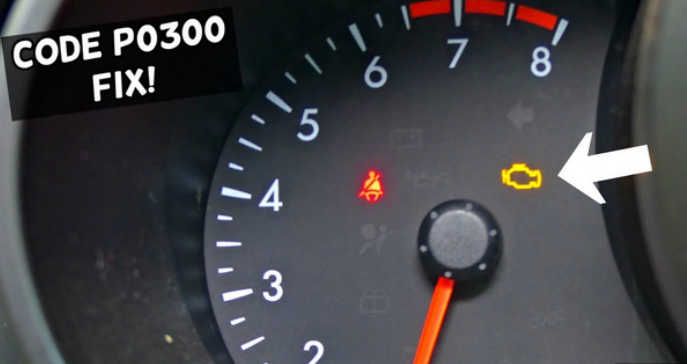
What is P0300?
Code P0300 is known as “Random or Multiple Cylinder Misfire Detected.”
This Diagnostic Trouble Code (DTC) indicates that your car’s computer has caught a random misfire, multiple cylinder misfire, or both.
There’s a high chance you’ll find another OBD-II fault code. Like P0300, related trouble codes such as P0301 and P0312 all suggest an engine misfire.
The last number in the code indicates the specific cylinder. For example, 1 denotes the misfiring cylinder in the P0301 error code. The cylinder number represents the cylinder numbered “1” in the engine configuration rather than the first one in the firing order.
Why?
Your car typically has 4-6 cylinders with a corresponding cylinder number, so the engine requires a firing order to function. The Powertrain Control Module controls this order to properly sequence the ignition system firing of the spark.
Using the fuel air mixture, the spark plug fires a spark to combust the fuel. As a result, the fuel releases energy powering the crankshaft — which needs to continuously turn as the car moves.
If more than one cylinder misfires, the crankshaft’s revolutions per minute (RPM) will increase or decrease. If that increase or decrease is over 2%, the Powertrain Control Module will capture a P0300 trouble code indicating a cylinder misfire in random or multiple cylinders. This code will also illuminate the check engine light.
Common Symptoms
When your car stores the OBD-II code P0300, you’ll likely experience one or more of the following symptoms:
- The check engine light is illuminated (in some vehicles, the check engine light may blink, which indicates a severe cylinder misfire that can damage the catalytic converter)
- Reduced fuel economy (increase in fuel consumption)
- The engine runs rough, hesitates, or jerks when accelerating
- Hard starting and extended cranking
- Fuel smell from the exhaust
- A failed emissions test
- Fluctuating engine speed
- The car takes longer to start up or doesn’t start up at all
- Rough idling
- Lack of power while driving
Can I Still Drive?
The P0300 trouble code is serious because it causes driveability problems. For example, your car may not start or idle rough. You may also experience decreased engine speed and increased fuel consumption. That’s why you shouldn’t delay resolving the check engine code P0300.
Also, since this fault code involves a concerning multiple misfire, it often arises with related misfire codes (from P0301-P0312 engine code, which indicate a misfire on a specific cylinder).
P0300 Causes
A multiple or random misfire can happen for many reasons — triggering the DTC P0300 misfire code and illuminating the check engine light.
Here are some of the common causes:
- Ignition System Problems
- Ignition system problems like a faulty spark plug, distributor, or ignition coils
- Damaged spark plug wire or coils
- Wiring problems (broken wires or a loose connector at the ignition coils or spark plugs)
- Worn distributor cap or rotor button
- Engine Problems
- Poor engine compression
- Engine mechanical problems such as a leaking head gasket or loose timing chain
- Damaged vacuum hose or a leaking intake manifold gasket
- Damaged camshaft or crankshaft position sensor
- Defective mass air flow sensor
- Faulty fuel injector
- Vacuum leak
- Fuel and Exhaust System Problems
- Fuel delivery issues like a weak fuel pump or clogged/faulty fuel injector
- A clogged fuel filter
- Low fuel pressure
- Clogged Exhaust Gas Recirculation or EGR valve
- Damaged oxygen sensor – A failing oxygen sensor can cause an improper air-fuel ratio, resulting in an engine misfire that triggers the P0300 code. That’s because the signal from the O2 sensor is one of the primary inputs to your car’s computer for fuel control.
- Faulty catalytic converter – Even though it’s rare, a faulty catalytic converter can trigger the code P0300. If the catalytic converter becomes restricted, it can produce enough back pressure to cause a misfire, triggering code P0300.
Diagnosis

Here’s how you will go about the diagnosis:
Step 1: First, use an OBD-II scan tool to draw freeze frame data and all of the DTCs stored by the Powertrain Control Module (PCM).
Step 2: take the car for a test drive to see if the P0300 trouble code is detected again. If the fault code isn’t cleared or the engine light still blinks, need review live data to identify each misfiring cylinder.
Step 3: Once done, need inspect the spark plugs or ignition coil packs for damaged wiring and check each plug for excessive wear. also thoroughly inspect the coil pack wires for corrosion or breaks at the harness and connector. If find any damage, need replace the coil, spark plug, or spark plug wires as needed.
Step 4: If the P0300 trouble code remains after each spark plug, spark plug wire, and/or coil pack has been replaced, inspect the entire fuel injector system for defects. If the fuel injector system is broken, you won’t have enough fuel in the fuel mixture, causing the persistent error code.
Step 5: If the fuel injector and ignition system operate correctly, check the fuel pressure. Low fuel pressure can cause an intermittent engine misfire on multiple cylinders. Typically the fuel pump or fuel pressure regulator is the source of low fuel pressure.
Step 6 (optional): If your car is old with a distributor cap and rotor button system, need inspect these parts for damage, cracks, or excessive wear.
Step 7: If your car stores other related trouble codes, diagnose and repair them. Once done, run a test drive to check if the P0300 trouble code returns.
Step 8: If the misfire code returns, check the compression system. A problem in the compressor is rare but likely for this code. If DTC P0300 persists, there may be a problem with the Powertrain Control Module requiring a replacement or reprogramming (also infrequent).